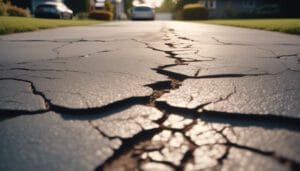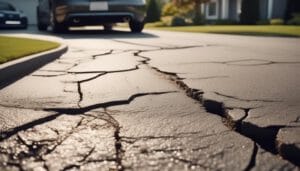As you step onto your driveway, you can’t help but notice the unsightly cracks that mar its smooth surface. It’s time to take action and restore its once flawless appearance. But where do you begin?
How do you fill those stubborn cracks that seem to be mocking you? Fear not, for with the right tools and techniques, you can bid farewell to those eyesores and restore your driveway to its former glory.
So, grab your gloves and let’s embark on a journey of driveway crack repair, where we’ll uncover the secrets to achieving a seamless and long-lasting result.
Key Takeaways
- Choose the appropriate filler based on the size and severity of the driveway cracks.
- Thoroughly clean and prepare the surface before filling the cracks for better adhesion.
- Consider using backer rods for larger cracks to provide structural reinforcement.
- Regular maintenance and sealing of the driveway can help prevent new cracks from forming.
Types of Fillers for Driveway Cracks
There are various types of fillers available for driveway cracks, including epoxy, polyurethane sealants, cementitious or polymer-based materials, and specialized resins for structural reinforcement. When it comes to filling cracks in your concrete driveway, it’s important to choose the right type of filler based on the size and severity of the cracks.
For smaller cracks, such as hairline cracks, epoxy or polyurethane sealants are often the best choice. These fillers are easy to apply and can effectively seal the cracks, preventing further damage. Simply clean the surface of the crack thoroughly, using a pressure washer if necessary, and then apply the filler using a caulking gun or a trowel.
For larger or deeper cracks, you may need to use a cementitious or polymer-based material. These fillers are designed to be more durable and can withstand heavier traffic. Before applying the filler, clean the crack and remove any loose debris. If the crack is wider than a quarter of an inch, consider using a concrete patching compound mixed with gravel for added strength.
In some cases, specialized resins for structural reinforcement may be necessary. These fillers are designed to provide additional support to the concrete and prevent further cracking. To use these fillers, clean the crack thoroughly and insert a concrete backer rod to provide a solid base for the filler. Then, apply the resin according to the manufacturer’s instructions.
Preparation for Crack Repair
To properly prepare for repairing cracks in your concrete driveway, you need to thoroughly clean the surface and remove any debris or vegetation. This will ensure a smooth and durable repair.
Here are the steps you should follow:
- Start by cleaning the cracks with a stiff wire brush, power washer, or air compressor. This will remove any dirt or loose particles that could interfere with the repair process.
- Use a weed-removing tool, spade, or lawn edger to get rid of any weeds or grass growing in the cracks. Make sure to remove them completely to prevent future growth.
- Dislodge any loose concrete particles using a power washer, garden hose, or air compressor. This will create a clean surface for the repair material to adhere to.
- If you notice any crumbled or soft concrete around the cracks, chip it away with a mason chisel or hammer. This will create a solid base for the repair and prevent further damage.
- Finally, clean any moldy or stained areas with a mixture of ¼ cup bleach and 16 cups of water. This will help remove any unsightly stains before filling the cracks.
Step-by-Step Crack Filling Process

Start by cleaning and preparing the surface of your driveway to ensure a successful crack filling process. Remove any weeds, grass, debris, or loose concrete using a weed-removing tool, wire brush, or power washer. Make sure the surface is clean and free from any contaminants.
Next, inspect the cracks on your concrete or asphalt driveway. If the cracks are small, use a cement mixture or vinyl concrete patching compound to fill them. For larger cracks, consider using a backer rod to provide support and then fill it with the appropriate sealant.
When filling the cracks, make sure to follow the manufacturer’s instructions and use the recommended sealant for your specific crack. Apply the sealant using a squeegee or paint roller, ensuring that it fills the crack completely.
After filling the cracks, create texture on the surface by using a broom. This will help improve the appearance and provide better traction on your driveway.
Allow the sealant to dry for the recommended time, typically around 24 hours, before using your driveway again.
Tips for Achieving Long-Lasting Results
For long-lasting results, address the underlying causes of cracks in your driveway, such as soil settlement and freezing/thawing cycles, to prevent future damage. To achieve this, follow these tips:
- Choose the right filler based on the size and type of crack. For small surface cracks, use crack fillers that are designed for concrete driveways. For deep cracks or structural issues, consider using specialized resins that provide structural reinforcement.
- Before filling the cracks, clean the surface of the driveway thoroughly. Remove any dirt, debris, or loose particles. This will ensure better adhesion of the filler and improve the longevity of the repair.
- Consider using self-leveling sealants for a smoother and more durable finish, especially for larger cracks or areas with heaving or sinking. These sealants have the ability to flow and level themselves, providing a seamless repair.
- Regularly maintain and care for the driveway to prevent new cracks from forming. This includes sealing the surface every few years to protect it from water penetration and freeze-thaw cycles.
Maintenance and Prevention Techniques
Regular maintenance and preventative measures are essential for preserving the integrity and longevity of your concrete driveway. By following a few simple steps, you can keep your driveway in top condition and prevent cracks from forming or worsening.
One important maintenance technique is to regularly fill any cracks that appear in your driveway. This will prevent water from seeping into the cracks and causing further damage. Use a concrete crack filler or a patching compound to fill the cracks, ensuring that the material is level with the surface of the driveway.
To prevent cracks from expanding, it is crucial to apply a sealant regularly. This protective coating will create a barrier against moisture and harsh weather conditions, preventing the cracks from getting worse. Use a high-quality driveway sealant and apply it according to the manufacturer’s instructions.
In order to maintain the overall integrity of your driveway, it is important to keep it clean and free from debris, weeds, and grass. Regularly sweep your driveway with a broom to remove any dirt or leaves that may accumulate. Additionally, consider using a weed killer or pulling out any weeds that may grow between the cracks.
For long-term prevention and to ensure quality results, it is advisable to seek professional maintenance and repairs. They have the expertise and tools to properly assess and address any issues with your driveway, ensuring its durability and longevity.
By following these maintenance and prevention techniques, you can keep your driveway in excellent condition and avoid costly repairs in the future. Regularly filling cracks, applying sealant, keeping it clean, and seeking professional help when needed are key steps to maintaining a beautiful and functional driveway.
| Maintenance and Prevention Techniques |
|---|
| Regularly fill cracks |
| Apply sealant regularly |
| Keep driveway clean |
| Seek professional maintenance and repairs |
Conclusion
Congratulations on successfully filling your driveway cracks! By following the step-by-step process and using the right fillers, you have ensured a durable and long-lasting repair.
Now, you can enjoy a smooth and aesthetically pleasing driveway.
Remember to regularly maintain and prevent future cracks to preserve your hard work.
Happy driving!



